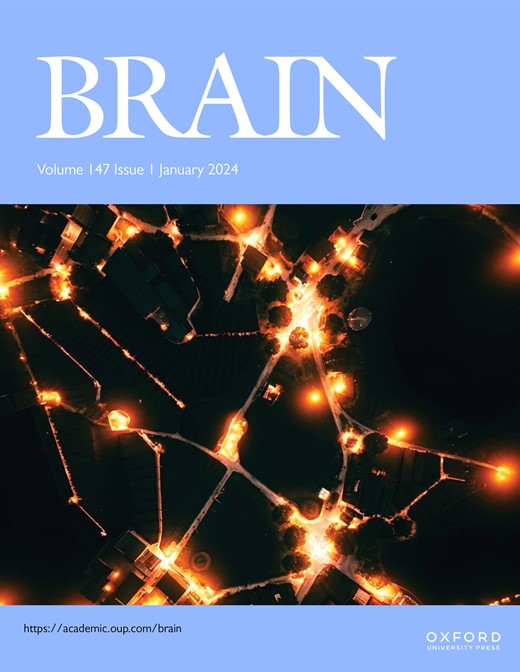Effects of atidarsagene autotemcel gene therapy on peripheral nerves in late-infantile metachromatic leukodystrophy
IF 10.6
1区 医学
Q1 CLINICAL NEUROLOGY
引用次数: 0
Abstract
This study evaluates the efficacy of arsa-cel gene therapy (GT) in mitigating the severity and progression of peripheral neuropathy as assessed by nerve conduction velocity (NCV) in individuals affected by late-infantile metachromatic leukodystrophy (LI-MLD). This is a post-hoc analysis conducted on pre-symptomatic patients affected by LI-MLD treated with ex vivo autologous hematopoietic stem cell GT (atidarsagene autotemcel, “arsa-cel”) in the context of prospective open-label, single-arm, interventional trials and expanded access programs. All patients were followed longitudinally with nerve conduction studies (NCSs) of peripheral motor (ulnar - UN, deep peroneal - DPN) and sensory (median - MN, sural - SN) nerves. These results were compared with those from a control group of untreated patients (NHx) studied with the same standardized protocol. We then analyzed the effects of baseline characteristics (age at treatment, severity of neuropathy pre-treatment expressed as age-matched NCV Z-scores) and arylsulfatase A (ARSA) enzyme activity (measured in peripheral blood myeloid CD15+ cells post treatment) on NCVs of treated patients. The primary endpoint of this post-hoc analysis was NCV, reflecting severity of demyelinating neuropathy. Changes in dermal nerve histopathology in skin biopsies were used as an exploratory outcome. Fifteen treated and 16 NHx patients were included in the analyses, with a median age (IQR) at treatment of 13 (9.1;14.5) months. At 36 months of age, treated patients showed higher estimated NCVs in all nerves compared to age-matched controls (∼15 m/s difference in motor nerves). Peripheral neuropathy was observed in the majority of treated patients at their pre-treatment examination (age range 7.3-17.4 months). Severity of pre-treatment neuropathy in treated patients did not have an effect on NCV values at 2 years post-GT, or on the rate of NCV slowing afterwards. A younger age at treatment was associated with higher NCVs of motor UN and sensory MN 2 years post-GT. Overall, ARSA levels in CD15+ cells correlated with NCVs of motor DPN at 2 years post-GT, and ARSA levels were associated with a slower decrease or a slight increase in NCVs of the DPN, UN and MN nerves afterwards. In summary, peripheral neuropathy assessed by NCV is significantly ameliorated in LI patients treated with arsa-cel compared to untreated patients of similar age. In addition to the potential role of early age at treatment in the preservation of myelin, supraphysiological ARSA levels may slow demyelination of the DPN and other peripheral nerves. Arsa-cel may exert a stronger effect on NCV than allogeneic hematopoietic stem cell transplantation due to its greater ARSA expression.atidarsagene自体细胞基因治疗对婴幼儿晚期偏色差性脑白质营养不良患者周围神经的影响
本研究通过神经传导速度(NCV)评估了arsa细胞基因治疗(GT)在婴幼儿晚期偏色差性脑白质营养不良(LI-MLD)患者中减轻周围神经病变严重程度和进展的疗效。这是一项在前瞻性开放标签、单臂、干预性试验和扩大准入计划的背景下,对接受体外自体造血干细胞GT (atidarsagene autotemcell,“arsa-cel”)治疗的LI-MLD症状前患者进行的回顾性分析。对所有患者进行纵向神经传导研究(NCSs),观察周围运动神经(尺神经- UN,腓深神经- DPN)和感觉神经(正中神经- MN,腓肠神经- SN)。将这些结果与采用相同标准化方案研究的未治疗患者(NHx)对照组的结果进行比较。然后,我们分析了基线特征(治疗时的年龄,治疗前神经病变的严重程度,以年龄匹配的NCV z评分表示)和芳基磺化酶A (ARSA)酶活性(治疗后外周血骨髓CD15+细胞测量)对治疗患者NCVs的影响。该事后分析的主要终点是NCV,反映脱髓鞘神经病变的严重程度。皮肤活检中真皮神经组织病理学的变化被用作探索性结果。15例接受治疗的患者和16例NHx患者被纳入分析,治疗时的中位年龄(IQR)为13(9.1;14.5)个月。在36个月大时,与年龄匹配的对照组相比,接受治疗的患者在所有神经中显示出更高的估计NCVs(运动神经差异约15 m/s)。治疗前检查(年龄7.3-17.4个月),大多数患者均有周围神经病变。治疗前神经病变的严重程度对gt后2年的NCV值或NCV减缓率没有影响。治疗年龄越小,gt后2年运动UN和感觉MN的NCVs越高。总的来说,CD15+细胞中的ARSA水平与gt后2年运动DPN的ncv相关,并且ARSA水平与DPN、UN和MN神经ncv的缓慢下降或轻微增加相关。总之,与未治疗的同龄LI患者相比,接受arsa- cell治疗的LI患者通过NCV评估的周围神经病变明显改善。除了早期治疗对保存髓磷脂的潜在作用外,生理上的ARSA水平可能会减缓DPN和其他周围神经的脱髓鞘。与异体造血干细胞移植相比,ARSA细胞表达量更高,对NCV的影响可能更大。
本文章由计算机程序翻译,如有差异,请以英文原文为准。
求助全文
约1分钟内获得全文
求助全文
来源期刊

Brain
医学-临床神经学
CiteScore
20.30
自引率
4.10%
发文量
458
审稿时长
3-6 weeks
期刊介绍:
Brain, a journal focused on clinical neurology and translational neuroscience, has been publishing landmark papers since 1878. The journal aims to expand its scope by including studies that shed light on disease mechanisms and conducting innovative clinical trials for brain disorders. With a wide range of topics covered, the Editorial Board represents the international readership and diverse coverage of the journal. Accepted articles are promptly posted online, typically within a few weeks of acceptance. As of 2022, Brain holds an impressive impact factor of 14.5, according to the Journal Citation Reports.
 求助内容:
求助内容: 应助结果提醒方式:
应助结果提醒方式:


